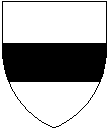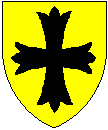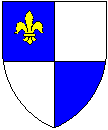
The first step is always to tell us about the background.
A blazon is a specialised description of a shield. To illustrate how to decode them consider the blazon Argent on a fess sable three bezants between three fleur-de-lys gules (Thwaites).
Step 1

The first step is always to tell us about the background.
Argent... This tells us the background or field is silver or white.
The colours used commonly are: argent=silver/white; gules=red; azure=blue; or=gold/yellow; sable=black; vert=green. For a full list see Colours.
Step 2

Next we place any major features, such as a fess (the horizontal band).
Argent on a fess sable... On the white background place a fess sable (black). Since the blazon contains the words “on a” we know there is more to come.
Step 3

Argent on a fess sable three bezants...Now we find out what is on the fess: three bezants, which are gold circles or roundles representing gold coins (the name suggests they were “Byzantine” coins).
Step 4

Then we place any other charges, in this case three fleur-de-lys (stylised flowers) gules (red).
Argent on a fess sable three bezants between three fleur-de-lys gules. And finally the blazon tells us what it is that the fess-plus-bezants is between: three fleur-de-lys gules.
You will notice that the object (background, fess or charge such as the fleur-de-lys) is named, then its colour is stated. Also, when there are three charges they are understood to be placed 2 above and 1 below.

Or a cross patonce sable (Vescy). This is a very simple blazon, telling us the background is or, that is gold/yellow, and the only charge is a cross sable or black. The patonce defines the shape of the cross, in this case one with the arms widening out and splaying into three.

Argent a chevron between three lions’ heads erased gules (Rocliff). The background field is argent, i.e. silver or white, on which the first or major charge is a chevron, and the secondary charges are three lions’ heads. As both the chevron and the heads are gules (=red) the colour is only stated once. The term erased describes the ragged edges of the heads; had they been cut off straight they would be couped.

Quarterly azure and argent, in the first quarter a fleur-de-lys or (Metham).
| 1 | 2 |
| 3 | 4 |